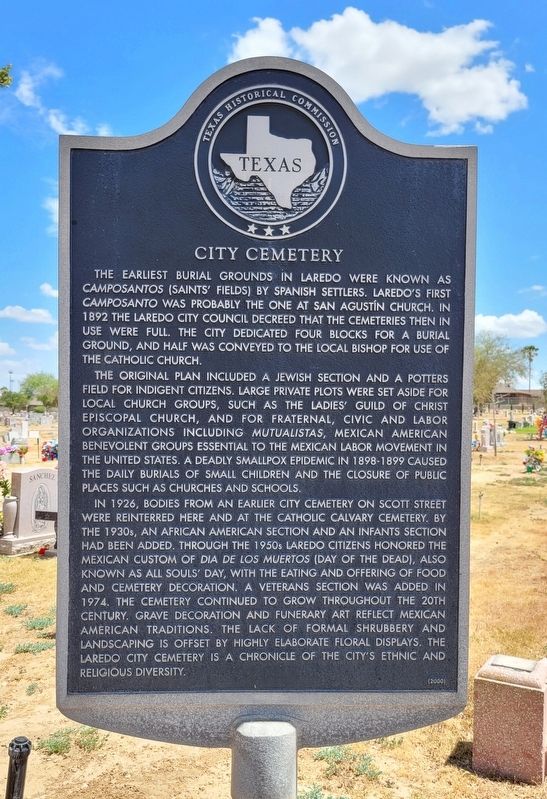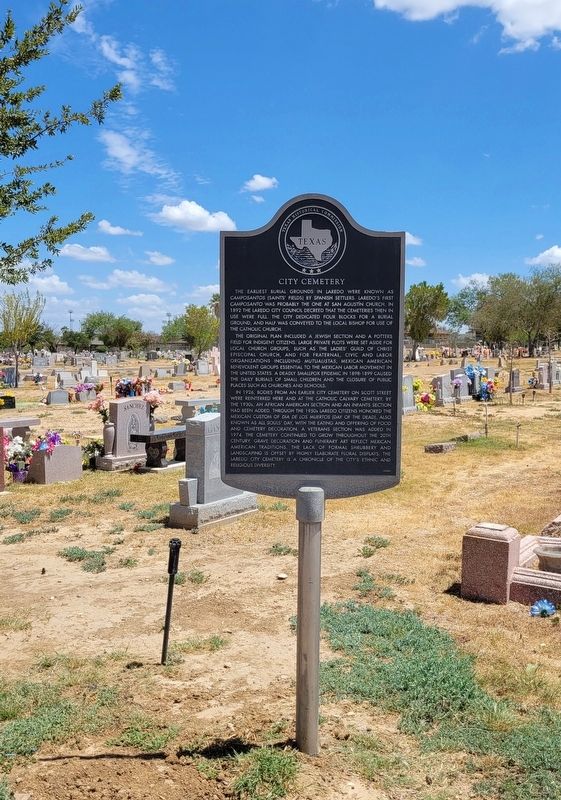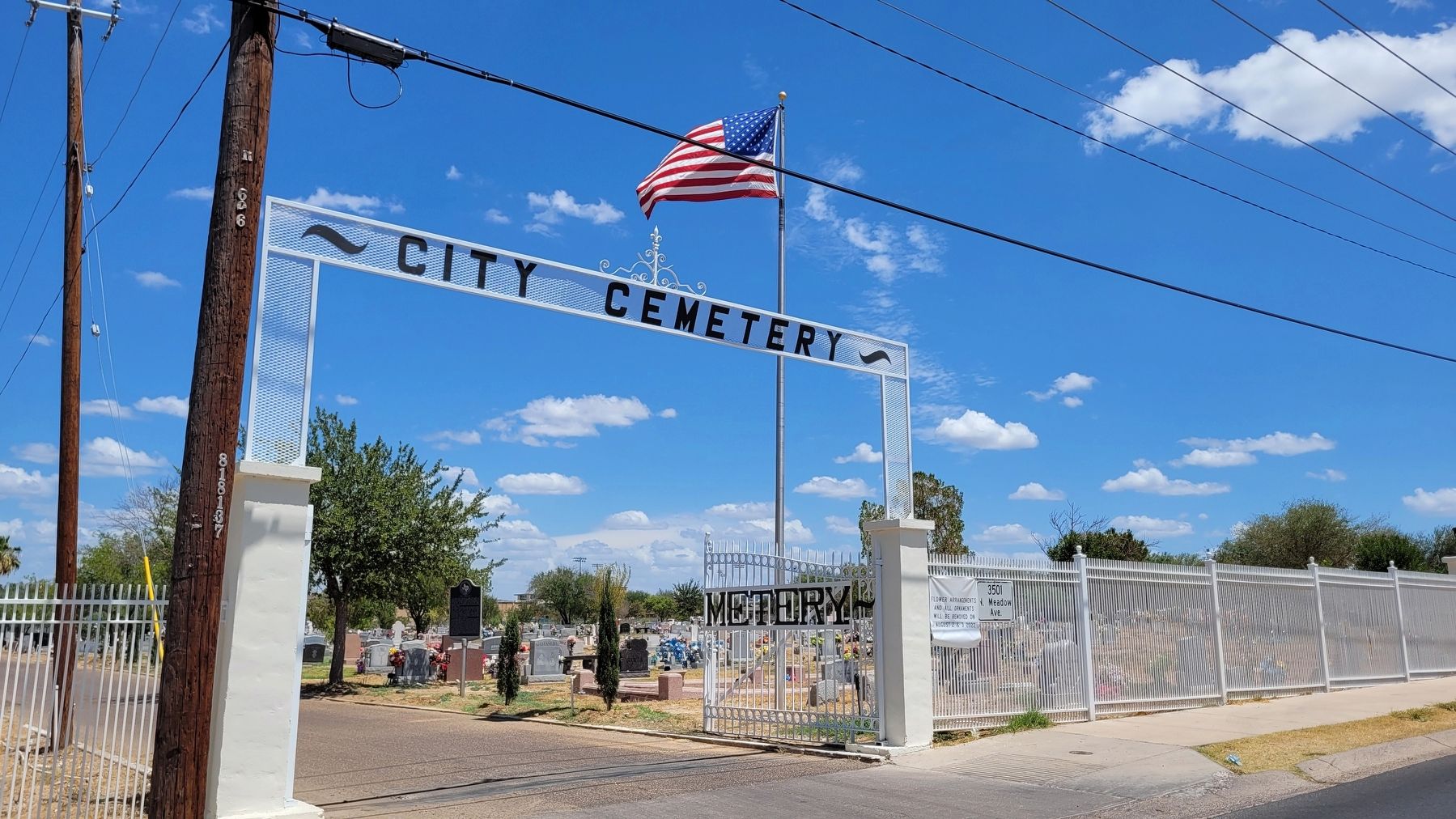Laredo in Webb County, Texas — The American South (West South Central)
City Cemetery
The original plan included a Jewish section and a potters field for indigent citizens. Large private plots were set aside for local church groups, such as the Ladies' Guild of Christ Episcopal Church, and for fraternal, civic and labor organizations including Mutualistas, Mexican American Benevolent groups essential to the Mexican labor movement in the United States. A deadly smallpox epidemic in 1898-1899 caused the daily burials of small children and the closure of public places such as churches and schools.
In 1926, bodies from an earlier city cemetery on Scott Street were reinterred here and at the Catholic Calvary Cemetery. By the 1930s, an African American section and an infants section had been added. Through the 1950s Laredo citizens honored the Mexican custom of Dia de los Muertos (Day of the Dead), also known as All Soul's Day, with the eating and offering of food and cemetery decoration. A veterans section was added in 1974. The cemetery continued to grow throughout the 20th century. Grave decoration and funerary art reflect Mexican American traditions. The lack of formal shrubbery and landscaping is offset by highly elaborate floral displays. The Laredo City Cemetery is a chronicle of the city's ethnic and religious diversity.
Erected 2000 by Texas Historical Commission. (Marker Number 12359.)
Topics. This historical marker is listed in these topic lists: African Americans • Cemeteries & Burial Sites • Fraternal or Sororal Organizations • Hispanic Americans. A significant historical year for this entry is 1892.
Location. 27° 31.668′ N, 99° 28.809′ W. Marker is in Laredo, Texas, in Webb County. Marker can be reached from North Meadow Avenue, 0.2 miles south of East Saunders Street (Business U.S. 59), on the right when traveling east. The marker is located in the western section of the City of Laredo Cemetery. Touch for map. Marker is at or near this postal address: 3200 North Meadow Avenue, Laredo TX 78041, United States of America. Touch for directions.
Other nearby markers. At least 8 other markers are within 3 miles of this marker, measured as the crow flies. Refugio Benavides (about 700 feet away, measured in a direct line); Bishop Peter Verdaguer (approx. 0.2 miles away); Santos Benavides (approx. 0.2 miles away); Calvary Catholic Cemetery (approx. 0.3 miles away); San Bernardo Avenue (approx. 1.6 miles away); Raymond and Tirza Martin High School (approx. 1.7 miles away); The Texas Mexican Railway (approx. 2.1 miles away); Webb County Courthouse (approx. 2.1 miles away). Touch for a list and map of all markers in Laredo.
Also see . . . Day of the Dead. Wikipedia
The Day of the Dead (Spanish: Día de Muertos or Día de los Muertos) is a holiday traditionally celebrated on November 1 and 2, though other days, such as October 31 or November 6, may be included depending on the locality. It largely originated in Mexico, where it is mostly observed, but also in other places, especially by people of Mexican heritage elsewhere. Although associated with the Western Christian Allhallowtide observances of All Hallow's Eve, All Saints' Day and All Souls' Day, it has a much less solemn tone and is portrayed as a holiday of joyful celebration rather than mourning. The multi-day holiday involves family and friends gathering to pay respects and to remember friends and family members who have died. These celebrations can take a humorous tone, as celebrants remember funny events and anecdotes about the departed.(Submitted on August 3, 2022, by James Hulse of Medina, Texas.)
Credits. This page was last revised on August 3, 2022. It was originally submitted on August 3, 2022, by James Hulse of Medina, Texas. This page has been viewed 218 times since then and 40 times this year. Photos: 1, 2, 3. submitted on August 3, 2022, by James Hulse of Medina, Texas.


